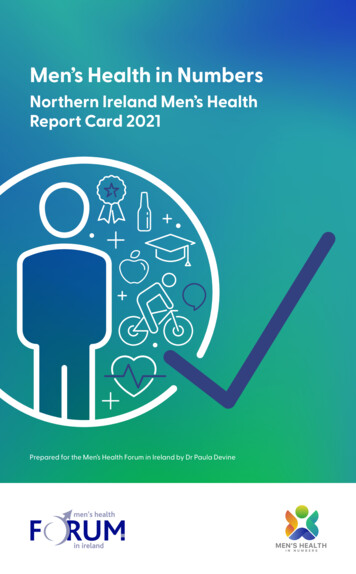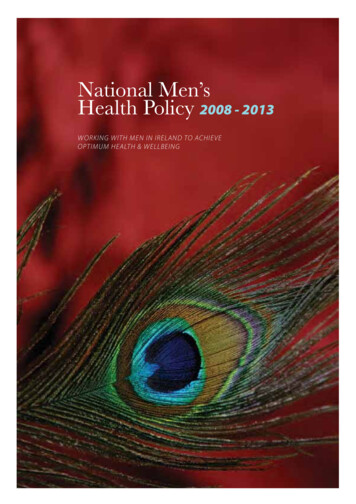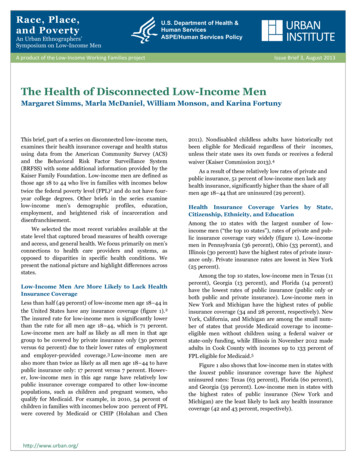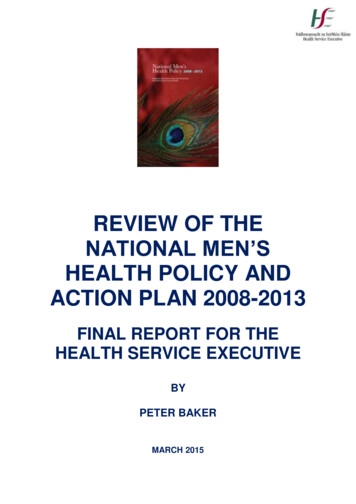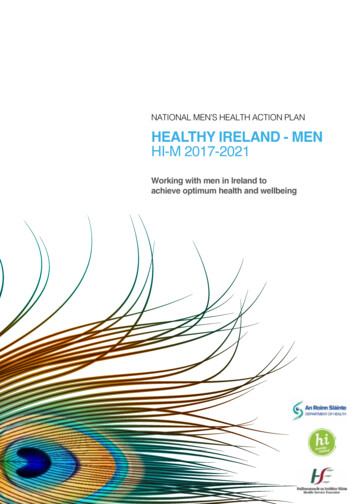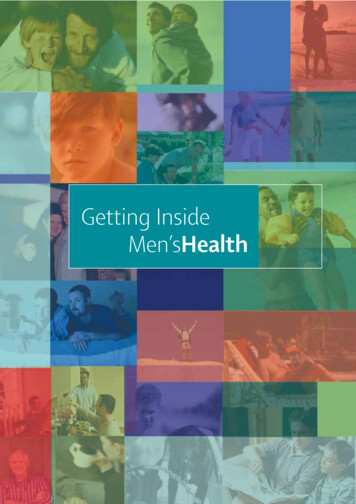
Transcription
Getting InsideMen’sHealth
Copies of this Report are available fromthe Health Promotion Department,South Eastern Health BoardTel: 056 7761400Email: kellyf@sehb.ieA PDF Copy of this Report is available atthe Health Promotion Unit website:www.healthpromotion.ieTo be cited asRichardson, N. (2004). Getting Inside Men’s Health.alth Promotion Department, South Eastern Health rdSláintean OirDheiscirtPublished by South Eastern Health Board December 2004ISBN: 1-874218-37-4 Reference Number is 10-04-0035Design and Print by Modern Printers: 056 7721739
CONTENTS
ForewordForewordIt gives me great pleasure to see the publication of Getting Inside Men’s Health. This reportprovides us with valuable and wide-ranging insights into many of the key issues pertainingto men’s health. The report is very timely, in that it will have an important function in termsof informing the development of a National Policy on Men’s Health.Whilst there has been an increased awareness of the statistics surrounding men’s health inrecent years, this report addresses in a very meaningful way, the issues that underpin thesestatistics. The report is highly comprehensive, both in terms of the range and depth ofquestions that it addresses, and in the use of both quantitative and qualitativemethodologies. As the report shows, the culture in which a man finds himself has a crucialbearing on his health status.Getting Inside Men’s Health will appeal to a wide audience – policy makers, serviceproviders, health and allied health professionals, and to those who work with men in thecommunity and voluntary sectors. The recommendations contained in the report offer aclear blueprint for developing policy and service-delivery measures for Irish men in theyears ahead.Pat McLoughlinChief Executive Officer South Eastern Health Boardi
ForewordI very much welcome the publication of this important research project on men’s health.Action 15 of the Health Strategy states that a policy for men’s health and healthpromotion will be developed. It further states that the Department of Health andChildren will take the lead role in preparing and driving a policy for men’s health inpartnership with the health boards and other agencies. The Health Promotion Strategy2000-2005 also identified the development of a national plan for men’s health as animportant initiative.The development of any national policy should be based on extensive consultation andcomprehensive research in order to ensure that all relevant stakeholders commit to thepolicy and that any resulting recommendations are evidence based. It is also essential, inthe case of a men’s health policy, that men are an integral part of the policy development.As an important first step in this process the Health Promotion Unit supported theappointment of a men’s health research officer in the South Eastern Health Board andcommissioned this research report in 2002 with a remit to research the role of gender andmasculinity on Irish men’s concept of health, document their knowledge, beliefs andattitudes to health and illness, health behaviours and risk behaviours and identify thebarriers that Irish men perceive in accessing the health services.The Unit has also commenced a consultation process and established a national steeringcommittee to oversee the development of a men’s health policy and action plan.The findings of this research “Getting Inside Men’s Health” will inform the developmentof the new men’s health policy and action plan which we hope to publish in 2005. I wouldlike to thank all involved in this important project, particularly the men who gave of theirtime to participate in the process.Chris FitzgeraldPrincipal Officer Health Promotion Unitii
AcknowledgementsThe author of this report wishes to acknowledge the input of each of the following tothe report:The Health Promotion Unit, Department of Health and Children, for funding theresearch.The South Eastern Health Board Men’s Health Steering Group:Ms Biddy O’Neill, Health Promotion Manager and Chair; Mr Shay McGovern, HealthPromotion Unit; Mr Alan O’Neill and Mr Lorcan Brennan, Men’s Development Network; DrTony Lee, GP Waterford; Mr Peter Kieran, South Eastern Health Board; Mr Fergus Hogan,Waterford Institute of Technology; Ms Anne Mcloughlin & Dr Paula Carroll, HealthPromotion Department.The Men’s Development Network, Waterford, who worked in partnership with theSouth Eastern Health Board to support the research.The Centre for Health Behaviour Research, Waterford Institute of Technology, forsupporting the research.Professor Harry Ferguson, Dr Norma Daykin & Dr Jon Pollock, Faculty of Health andSocial Care, University of the West of England.Mr Cormac Forkin, National University of Ireland, Galway, for his assistance with statisticalanalysis.Ms Aine Duggan, University of Bath, for her assitance with qualitative analysis.iii
CONTENTSSECTION 1 INTRODUCTIONIntroduction‘Men’s Health’– Background and OriginsPrinciples Underpinning Men’s HealthMen’s Health DefinedMen’s Health in Ireland – Developing a Research FrameworkSECTION 2 SUMMARY OF KEY STATISTICS ON IRISH MEN’S HEALTH2.1 Life Expectancy2.2 Mortality2.3 Morbidity2.4 Lifestyle/Health Behaviours2.4.1 Alcohol2.4.2 Smoking2.4.3 Overweight/obesity & dietary habits2.4.4 Exercise/physical activity2.5 Risk Behaviours2.5.1 Convictions for various offences2.5.2 Accidental injury2.5.3 Drugs123567111112141515171818191919192.5.4 Sexual activity and sexually transmitted infections (STIs)2.5.5 Domestic violence2.6 Men’s Health - Knowledge/Awareness/Attitudes to Health & Health Screenings2.7 Men’s Health - Accessing Health Services2.8 Critique of ‘Sex Differences’ Literature2.9 Conclusion202121222527SECTION 3 GENDER, MASCULINITIES AND HEALTH3.1 Introduction3.2 Men’s Health – A Gendered Approach3.3 Origins of ‘Masculinity’ – Moving from ‘Sex-Role’ Theory to a Social Constructionist Viewof ‘Masculinities’3.4 Masculinities and Work3.5 Masculinities and Health3.6 Masculinities Research in Ireland3.7 Conclusion28303032SECTION 4: AIM, OBJECTIVES & METHODOLOGY OF STUDY4.1 Aim4.2 Objectives4.3 Study Design4.4 Study 1: Qualitative Study (Focus Groups)4.4.1 Introduction4.4.2 Methodology4.4.3 Analysis of data4.4.4 Results373838393939393939iv34343636
CONTENTS4.5 Study 2: Quantitative Postal-Questionnaire Study4.5.1 Introduction4.5.2 Questionnaire design and data collection4.5.3 Analysis of dataResults4.6 Study 3: Qualitative Semi-Structured Interview Study4.6.1 Introduction4.6.2 Methodology4.6.3 Analysis of data4.6.4 Results4.7 Overall methodological considerations from this study that may have implications forfuture men’s health research initiatives3939394040404040414141SECTION 5 RESULTS - STUDY 2: QUANTITATIVE POSTAL-QUESTIONNAIRE STUDY5.1 Demographic Profile of Sample Population5.2 Male Patients’ Views on Accessing GP Care5.2.1 Length of time since attendance at doctor5.2.2 Male patients’ perceptions of GP care5.2.3 Barriers around male patients attending their doctor5.3 Self-Reported Health Status and ‘Self-Care Practices’5.3.1 Self-reported health status5.3.2 Neglect of health as a contributory factor to self-reported ‘poor’ health5.3.3 Self-reported long-term illness/disability5.3.4 Late presentation as a contributory factor to self-reported long-termllness/disability5.3.5 Male patients sense of personal responsibility in relation to health5.4 Lifestyle/Health Behaviours5.4.1 Alcohol consumption5.4.2 Smoking5.4.3 Physical activity levels5.4.4 Stress5.5 Preventative Health Behaviours5.5.1 Monitoring of weekly alcohol consumption5.5.2 Experience of ‘Digital Rectal Examination’ (men aged 50 or over)5.2.3 Practicing of ‘Testicular Self Examination’ (TSE)5.2.4 Stress management5.6 Risk Behaviours5.6.1 Use of seat belts5.6.2 Drink driving5.6.3 Speeding5.6.4 Use of sun screen5.6.5 ‘Safe’ sex5.7 Knowledge/Awareness of Health5.7.1 Life expectancy5.7.2 Male specific health5.7.3 Lifestyle 6465656667686868686971
CONTENTS5.7.4 Mental health5.8 Emotional/Relational Health5.8.1 ‘Men’s process’5.8.2 Source of support for emotional/mental health issue5.8.3 Impact of relationships on mental health and well-being5.9 Impact of Marriage/Cohabiting & Fatherhood on Health5.9.1 Marriage/Cohabiting5.9.2 Fatherhood7373737474747475SECTION 6 COMPOSITE SCORES MEN’S HEALTH6.1 Composite Score Self Reported Health Status6.2 Composite Score Self Care Practices6.3 Composite Score Health Behaviours6.4 Composite Score Preventative Health Behaviours6.5 Composite Score Risk Behaviours6.6 Composite Score Knowledge/Awareness of Health6.7 Relationship Between Men’s Health Composite Scores and Socio-Demographic Factors6.8 Inter-Relationships Between Men’s Health Composite Scores808080818182838384SECTION 7DISCUSSION OF FINDINGS FROM BOTH QUANTITATIVE AND QUALITATIVE STUDIES7.1 Men’s Health Consciousness and Concept of Health7.1.1 Are men health-conscious?7.1.2 Men’s concept of health7.1.3 Summary and conclusion7.2 Male Patients views on GP Care7.2.1 Men do attend their GP!7.2.2 Women continue to play a key role in the help-seeking behaviour of men7.2.3 Men prefer male GPs7.2.4 It may still be with reluctance that men go to their GP7.2.5 Why are men reluctant attenders at their GP?7.2.6 Summary and conclusion7.3 How Men Cope with Illness7.3.1 Coping with illness – a sliding scale of acceptability7.3.2 A desire for certainty when facing illness7.3.3 The ‘strong silent’ type - putting things off for as long as possible7.3.4 Men may opt to accept a modified or curtailed lifestyle rather than to seek help7.3.5 An acknowledgement of the need to change7.3.6 Summary and conclusion7.4 Self Reported Health Status and ‘Health Neglect’7.4.1 Self–reported health status7.4.2 Poor’ health status attributed to health neglect7.4.3 Self-reported long-term illness/disability7.4.4 Late presentation a contributory factor to self-reported long-termillness/disability7.4.5 Men’s own perceptions of how they neglect health7.4.6 Men’s own perceptions of what would have been needed to 7107107107108108108108
CONTENTShealth more effectively7.4.7 Summary and conclusion7.5 Lifestyle/Health Behaviours7.5.1 Alcohol7.5.2 Smoking7.5.3 Physical activity levels7.5.4 Stress7.5.5 Summary and conclusion7.6 Preventative Health Behaviours7.6.1 ‘ if it ain’t broken don’t fix it’7.6.2 Monitoring alcohol consumption7.6.3 Male-specific preventative health7.6.4 Stress management7.6.5 Summary and conclusion7.7 Risk Behaviours7.7.1“ he’ll stick his chest out and have a go at it”7.7.2 Use of seat belts7.7.3 Drink - driving7.7.4 Speeding7.7.5 Use of sunscreen7.7.6 Unsafe sex7.7.7 ‘Adrenalin Junkies’& the impact of the peer group on risk-taking7.7.8 Summary and conclusion7.8 Knowledge/Awareness of Health7.8.1 Are Irish men knowledgeable about their own health?7.8.2 Summary and conclusion7.9 Emotional/Relational Health7.9.1 ‘Men’s process’7.9.2 Applying ‘logical’ solutions to emotional problems7.9.3 ‘Controlling’ the emotional self7.9.4 The struggle between resisting and yielding to depression7.9.5 Re-connecting with emotional self7.9.6 Source of support for emotional/mental health issue7.9.7 Summary and conclusion7.10 Impact of Marriage/Cohabiting & Fatherhood on Health7.10.1 Marriage/Cohabiting7.10.2 Fatherhood7.11 Men’s Health Composite Scores7.11.1 Relationship between men’s health composite scores andsocio-demographic factors7.11.2 Inter-relationships between men’s health composite 24125127127127128130SECTION 8 CONCLUSIONS AND 30133
LIST OF FIGURESFigure 1.3.1Factors that influence health5Figure 1.3.2Conceptual framework for men’s health5Figure 2.1.1Life expectancy at birth for males and females in EU Countries11Figure 2.1.2Ratio of females to males 1996-200311Figure 2.1.3Population by gender and age 200211Figure 2.1.4Changes in life expectancy by gender since 1920 in Republic of Ireland12Figure 2.1.5Number of males/females aged 85 in Ireland, 1961-199612Figure 2.2.1Ratio of mortality rates male: female due to all causes of death13Figure 2.2.2Annual mortality rates (per 100,000) by age and gender, 1989-9813Figure 2.2.3Relative risk of dying from various causes, comparing highest occupational group withlowest occupational group14Figure 2.3.1Acute hospital discharges in Ireland 1998Figure 2.3.2All admissions to psychiatric hospitals in Ireland 2001 – selected diagnostic groups andgender (rates per 100,000)15Figure 2.4.3Levels of overweight and obesity among Irish men and women18Figure 2.5.5Domestic violence complainants and offenders by gender, 200221Figure 4.3.1Study Design39Figure 5.1.1Age distribution of sample population44Figure 5.1.2Education distribution of sample population44Figure 5.1.3Social class (SC) distribution of sample population44Figure 5.2.1Doctor-patient communication48Figure 5.2.2Frequency of leaving doctor’s surgery with unanswered/unasked questions49Figure 5.2.3Interpersonal aspects of GP care50Figure 5.2.4Perception of GP’s knowledge of patients50Figure 5.2.5‘Enablement’ – how patients generally feel after a visit to the doctor51Figure 5.2.6Disposition towards going to the doctor52Figure 5.2.7Preference for male/female doctor54viii14
List of FiguresFigure 5.3.1Relationship between self-reported ‘good’ health and self-reported physical activity55Figure 5.3.2Neglect of health as a reason for poor health (n 222)55Figure 5.3.3Percentage with long-term illness, health problem or disability55Figure 5.3.4Relationship between having a long-term illness/health problem and (i) age and (ii)education55Figure 5.3.5Percentage indicating that problem could have been cured/managed better if help wassought sooner (n 181)56Figure 5.3.6How respondents have looked after their own health over the course of their lives56Figure 5.3.7Percentage of men within different categories who reportedneglect of their health in relation to (i) age; (ii) social class and (iii) education56Figure 5.4.1‘Excessive’ drinkers by age59Figure 5.4.2Relationship between ‘At least weekly binge drinking’ andsocio-demographic factors60Figure 5.4.3Binge drinkers and excessive drinkers perceptions of their own alcohol consumption61Figure 5.4.4Levels of reported stress62Figure 5.6.1Relationship between ‘driving having had two or more alcoholic drinks’ and sociodemographic factors66Figure 5.6.2Relationship between having been ‘a passenger in the past year with a driver who wasdrunk’ and socio-demographic factors67Figure 5.6.3Relationship between non-compliance with speed limits and socio-demographic factors67Figure 5.9.1Marriage/Cohabiting has resulted in me becoming75Figure 5.9.2Perception of provider role identity76Figure 5.9.3Overall responsibility for managing/caring for children76Figure 5.9.4Percentage of fathers of ‘younger’ and ‘older’ children answering‘Agree’/’Strongly Agree’ to work/fatherhood balance77Percentage of fathers of ‘younger’ and ‘older’ children answering‘Agree’/’Strongly Agree’ to impact of fatherhood on health practices77Figure 7.1.2Orientations used to conceptualise health90Figure 7.9Inter-relationships between men’s health composite scoresFigure 5.9.5ix133
List of TablesTable 2.2.1Annual directly standardised mortality rates (DSMR) and directly standardisedmortality rate ratios for females and males in the Republic of Ireland, 1989-199813Table 2.3.1Perceived general health by gender14Table 2.4.1Drinking patterns among men and women in Ireland (2002) in comparison with the ECAScountries (All respondents aged 18-64)16Table 2.4.2Prevalence (%) of cigarette smoking by sex and age18Table 2.5.1Persons convicted of various offences in 2002, Republic of Ireland19Table 2.5.3Drug use in Ireland 2002/200320Table 2.5.4Notified sexually transmitted infections by age group (years) and gender20Table 5.1.1Marital status45Table 5.1.2Parental status45Table 5.2.1Length of time since attended doctor45Table 5.2.2Satisfaction with practice opening hours46Table 5.2.3Additional hours for practice to be open46Table 5.2.4Waiting times46Table 5.2.5Duration of consultations47Table 5.2.6Frequency of seeing own doctor47Table 5.2.7Issues perceived as ‘difficult to talk to your doctor about’49Table 5.2.8Overall satisfaction with practice51Table 5.2.9Factors associated with reluctance to go to doctor52Table 5.2.10Factors that cause fear or anxiety about going to the doctor53Table 5.2.11Sex of doctor53Table 5.3.1How health has been over past 12 months54Table 5.3.2Examples of how health has been neglected that have resulted in health problems (n 191)57Table 5.3.3Cross-tabulation (Chi-Square) between approach to looking after health and other variables57Table 5.3.4Examples of what would have been needed to manage health problems (n 133)58Table 5.4.1Units of alcohol consumed per week59x
List of TablesTable 5.4.2Frequency of ‘binge drinking’ (6 drinks or more)60Table 5.4.3‘Drinkers’ perception of their own alcohol consumption60Table 5.4.4Incidence of smoking61Table 5.4.5Cigarette consumption61Table 5.4.6Desire to stop smoking62Table 5.4.7Level of physical activity/exercise over past few months62Table 5.4.8Factors contributing to stress63Table 5.5.1Monitoring of weekly alcohol consumption63Table 5.5.2Experience of ‘Digital Rectal Examination’ (Men aged 50 )64Table 5.5.3Knowledge of how to practice ‘Testicular Self Examination64Table 5.5.4Frequency of practicing ‘Testicular Self Examination’64Table 5.5.5Perceived effectiveness at managing stress64Table 5.5.6Behaviours used to manage stress64Table 5.5.7Relationship between self-reported effectiveness at managing stressand other variables (Chi Square; p .05)65Table 5.6.1Frequency of seat belt use65Table 5.6.2Drink driving66Table 5.6.3Adherence to speed limits when driving67Table 5.6.4Use of sun screen if skin is exposed to the sun for extended periods68Table 5.6.5Frequency of sex with non long-term partner without using a condom68Table 5.7.1Estimation of life expectancy for Irish males and Irish females69Table 5.7.2Knowledge of function and location of prostate gland69Table 5.7.3Understand term ‘Digital Rectal Examination’69Table 5.7.4Knowledge of Prostate Cancer Symptoms amongst men 50 years and over (n 279)70Table 5.7.5Age category at highest risk of developing testicular cancer70Table 5.7.6Knowledge of risk factors for developing testicular cancer70Table 5.7.7Knowledge of ‘Testicular Self Examination’70Table 5.7.8Knowledge of how to avoid contracting or transmitting an STI71xi
List of TablesTable 5.7.9Knowledge of issues relating to vasectomy71Table 5.7.10Knowledge of recommended nutritional intake71Table 5.7.11Healthy range of percentage body fat for men72Table 5.7.12Recommended type and amount of physical activity for health gain72Table 5.7.13Sensible drinking limit for males per week72Table 5.7.14Awareness of health consequences of smoking73Table 5.7.15Knowledge of symptoms of depression73Table 5.8.1Reaction when something affects emotional/mental well-being73Table 5.8.2Source of support for emotional/mental health problem74Table 5.8.3Impact of relationships with ‘significant others’ on overall mental health and well-being74Table 5.9.1Does marriage/Cohabiting result in men taking more care of their own health?75Table 5.9.2Division of parental responsibilities in relation to managing/caring for children76Table 6.1Criteria used to compile composite ‘self-reported health’ score80Table 6.2Composite score self-reported health80Table 6.3Criteria used to compile composite ‘self-care practices’ score80Table 6.4Composite score self care practices81Table 6.5Criteria used to compile composite health behaviour score81Table 6.6Composite score health behaviours81Table 6.7Criteria used to compile composite preventative health behaviour score81Table 6.8Composite score preventative health behaviours82Table 6.9Criteria used to compile composite risk behaviour score82Table 6.10Composite score risk behaviours82Table 6.11Criteria used to compile composite knowledge/awareness of health score83Table 6.12Composite score knowledge/awareness of health83Table 6.13Relationship between men’s health composite scoresand socio-demographic factors (Chi Squared p .05)83Table 6.14Inter-relationships between men’s health composite scores85xii
INTRODUCTION
Some welcome men’s health initiatives have also emergedwithin Ireland in recent years. For example, the NorthWestern Health Board (North Western Health Board, 1998)was the first board to co-ordinate a dedicated conferenceon men’s health, whilst the Western Health Board (WesternHealth Board, 2000), became the first Board to devise aregional men’s health promotion strategy. The NorthEastern Health Board (2001) conducted qualitativeresearch on the beliefs, attitudes and perceptions of men inrelation to health, and has since been actively involved inpromoting men’s health within the region. The presentstudy evolved from the work of a men’s health steeringgroup in the south-east region, which includes membersfrom both statutory and community sectors and is chairedby the Health Promotion Manager, South Eastern HealthBoard. The study is a joint Health Promotion Unit/SouthEastern Health Board initiative. It should also beacknowledged that many statutory and voluntaryorganisations nationally, have been working towards abroad agenda of men’s health and men’s health-relatedissues. For example, the Irish Cancer Society launched aninnovative campaign in 2003 directed at increasingawareness and early detection of cancers among men, andis shortly to commission research around cancer preventionand early detection of cancer in adult men in Ireland. TheCrisis Pregnancy Agency has in recent times funded anumber of research initiatives with a focus on men,including fathers’ experiences of crisis pregnancies, and thebarriers around men’s use of sexual health services. Sincethe early 1990s, the Men’s Development Network inWaterford has been engaged in wide-rangingdevelopmental work with men from socially disadvantagedareas, that seeks to positively impact on men’s health.Other organisations such as AMEN (support for malevictims of domestic violence) and Parental Equality(support for separated/divorced fathers) are issue based,and with a specific focus in the broader context of ‘men’shealth’. The Men’s Health Forum in Ireland (www.mhfi.org)has been engaged in men’s health work at an advocacylevel since 2002, and in January 2004 launched the mostcomprehensive report to date on men’s health statistics inIreland (McEvoy and Richardson, 2004). The recentpublication of an All-Ireland Men’s Health Directory (TheInstitute of Public Health, 2004) provides a very worthwhiledatabase of activity in the area of men’s health on the islandof Ireland.1.1 Introduction Section 1Despite men’s very prominent and powerful presencethroughout the ages at the centre of health discourse, menhave been conspicuously silent and largely non-reflectiveabout defining or highlighting ‘men’s health’ issues. Whilstmen have been the predominant players in the decisionmaking process affecting health research and health servicepolicy and provision, men themselves have not argued,lobbied or campaigned in the same way that women have,for improvements to their health at a personal or individuallevel. There has been a tendency in the literature to focuson the ‘health’ issues of ‘men’s health’, with comparativelyless focus on ‘men’, or more specifically, men as genderedbeings (Connell et al, 1998). For example, Courtenay(2000b) states that although male bodies are often used toresearch the aetiology and treatment of wide-rangingdiseases, men are rarely studied as patients, or as men. Thishistorical context is in marked contrast to the relativelyrecent upsurge of interest in men’s health in the academicand popular press, and more tentatively at a policy level.The first World Congress on men’s health was held inVienna in 2001, and there have been a number of NationalConferences on men’s health in Australia, the United Statesand Europe. Other international initiatives in recent yearsinclude the launch of the International Society for Men’sHealth, the commencement of an International Men’sHealth Week, the launch of the European Men’s HealthForum (EMHF), and the introduction of two academicjournals devoted to men’s health (The International Journalof Men’s Health and The Journal of Men’s Health andGender). The launch of the EMHF’s report in 2003 (Whiteand Cash, 2003) provided for the first time, acomprehensive overview of statistics on men’s healthacross Europe. Australia has been to the forefront duringthe 1990s in advancing men’s health at a policy level, aswell as being driven by local men’s groups and communityservice organisations, and private sector men’s healthservices. As well as hosting a number of National Men’sHealth Conferences, there has also been a draft nationalmen’s health policy for Australia, and the development oftaskforces, advisory groups and policy and strategydocuments within individual states. Closer to home, the UKMen’s Health Forum has recently launched its draft policyfor men’s health (‘Getting it Sorted’ - Wilkins and Baker,2004), and acts as the secretariat for an all-partyparliamentary group on men’s health.Whilst these initiatives are evidence of a very welcome andsignificant shift towards an increased awareness aroundmen’s health issues, men’s health at an overall strategic andservice delivery level remains fragmented and ad-hoc. Froma very limited knowledge base and in the absence of a clearset of guiding principles to direct policy and practice, those2
individuals and organisations that are interested in men’shealth continue to operate largely in a vacuum. Whilst theissue of women’s health, both nationally (Department ofHealth and Children, 1997) and within each health boardarea (e.g. Women’s Health in the South East 2000 andbeyond – South Eastern Health Board, 2000), has been thesource of extensive consultation and careful strategicplanning, the same cannot be said for men’s health. Indeed,men have not until very recently (Department of Healthand Children, 2000; 2001), been identified as a targetpopulation group for the strategic planning of health care.Other policy documents such as those on alcohol(Department of Health and Children, 1996) andcardiovascular disease (Department of Health and Children,1999) highlight specific health statistics relating to men,but stop short of identifying the reasons underlying thedisproportionate representation of men within thestatistics, or of forming gender-specific action plans to dealwith the issues raised. The state of inertia towards men’shealth at a strategic planning level seems to be linked to anoverall lack of development of men’s health policy andpractice at a local level. It is against such a backdrop that therelevance of this research report becomes most apparent,particularly in terms of helping to inform the developmentof a national policy for men’s health in Ireland.social class, sexual orientation, race, marital status andurban/rural issues - all have a significant bearing on healthstatus for men and indeed for women. For example, theleading causes of death among older men are very differentfrom those of younger men. The incidence of sexuallytransmitted infections (STI’s) and HIV is disproportionatelyhigher among gay men compared to heterosexual men.The statistics in relation to health and social class areparticularly damning (Public Health Alliance, Ireland, 2004),with those from lower social classes sufferingdisproportionate levels of ill-health. A number of otherimportant and well documented factors also contribute tohealth and longevity, including education (Pekkanen et al,1995), access to health care (Humphreys, Mathews-Cowey& Weinard, 1997)), and employment status (Mathers andSchofield, 1998).In light of the profound impact that these factors relatingto social disadvantage have on health, the question maywell be asked as to what extent men’s health is in fact sexspecific. At one level, this question is answered by seekingout studies on health measures that control for level ofdisadvantage, the vast majority of which still show betterhealth outcomes for women (Schofield et al, 2000). Suchstudies provide telling evidence that simply ‘being male’accounts for the margins of difference in health outcomesbetween women and men. Whilst the focus of attentiontypically turns to biological differences, there is now a gro1.2 ‘Men’s Health’Background and OriginsWhilst the flagging of men’s health ‘for action’ in Qualityand Fairness (Department of Health and Children, 2001) isa welcome first step, it must be said that there remains afundamental lack of understanding and clarity about whatis meant by ‘men’s health’. In particular, the over-simplisticuse of the term is indicative of a single, homogeneous setof men’s health issues which fails to take account of thediversity that exists between different groups of men. Thereis a tendency in the literature to focus on the margins ofdifference between men’s and women’s rates of morbidityand mortality from different illnesses, diseases and lifestyleissues, with particular reference to sex specific diseases(especially prostate and testicular cancer). To focus solelyon this ‘sex-differences’ literature may have shortcomings(see Section 2.8), and in particular, men’s health needs tobe defined as an issue in its own right. The ‘value’ of thisliterature is perhaps most pronounced in terms of lobbyingfor more resources to be allocated to men’s health.However, careful and cautious analysis of such statistics isnecessary, particularly where policy or service delivery issuesmay be under consideration.It must be stressed that a number of other factors - age,3
growing
2.6 Men's Health - Knowledge/Awareness/Attitudes to Health & Health Screenings 21 2.7 Men's Health - Accessing Health Services 22 2.8 Critique of 'Sex Differences' Literature 25 2.9 Conclusion 27 SECTION 3 GENDER, MASCULINITIES AND HEALTH 28 3.1 Introduction 30 3.2 Men's Health - A Gendered Approach 30

